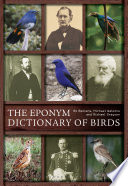Taphrospilus
Well-known member
Amazona dufresniana (Shaw, 1812) v.8:pt.1-2 (1812) - General zoology, or Systematic natural history - Biodiversity Heritage Library due to t.2 (1805) - Histoire naturelle des perroquets - Biodiversity Heritage Library and t.2 (1805) - Histoire naturelle des perroquets - Biodiversity Heritage Library
Columba dufresnii Stephens, 1819 v.11:pt.1 (1819) - General zoology, or Systematic natural history - Biodiversity Heritage Library and plate v.11:pt.1 (1819) - General zoology, or Systematic natural history - Biodiversity Heritage Library
Fringilla dufresni Vieillot, 1817 t.12 (1817) - Nouveau dictionnaire d'histoire naturelle - Biodiversity Heritage Library
Coccopygia dufresnii Reichenbach, 1863 [Abt.4]:Bd.4 (1862) [Text] - Die vollständigste Naturgeschichte der Vögel - Biodiversity Heritage Library
As I understood Fringilla dufresni and Coccopygia dufresnii are not the same birds. Or am I wrong?

 birdsoftheworld.org
birdsoftheworld.org
I think it is correct and everthing in accordance with t.2 (1833) - Nouvelles annales du Muséum d'histoire naturelle - Biodiversity Heritage Library and Recherche - Base de données Léonore or https://www.tandfonline.com/doi/abs/10.1080/00033797000203397 or Papers of Louis Dufresne - Archives Hub Louis Dufresne, jefe del laboratorio de Taxidermia del Museo de París.
I am just wondering where he died as I couldn't find any hint in Filae that he died in Paris. He may have been burried there.
Others non birds:
Echinus dufresnii Blainville , 1825
 www.biodiversitylibrary.org
Bulimus dufresnii Leach, 1815 v.2 (1815) - The zoological miscellany - Biodiversity Heritage Library
www.biodiversitylibrary.org
Bulimus dufresnii Leach, 1815 v.2 (1815) - The zoological miscellany - Biodiversity Heritage Library
Cymothoa dufresni Leach, 1818 t. 12 (1818) - Dictionnaire des sciences naturelles - Biodiversity Heritage Library
No idea which mammal may named for him
Columba dufresnii Stephens, 1819 v.11:pt.1 (1819) - General zoology, or Systematic natural history - Biodiversity Heritage Library and plate v.11:pt.1 (1819) - General zoology, or Systematic natural history - Biodiversity Heritage Library
Fringilla dufresni Vieillot, 1817 t.12 (1817) - Nouveau dictionnaire d'histoire naturelle - Biodiversity Heritage Library
Coccopygia dufresnii Reichenbach, 1863 [Abt.4]:Bd.4 (1862) [Text] - Die vollständigste Naturgeschichte der Vögel - Biodiversity Heritage Library
As I understood Fringilla dufresni and Coccopygia dufresnii are not the same birds. Or am I wrong?
The Eponym Dictionary of Birds
A comprehensive dictionary listing all the people whose names are commemorated in the English and scientific names of birds.Birdwatchers often come across bird names that include a person's name, either in the vernacular (English) name or latinised in the scientific nomenclature. Such names are...
books.google.de
Dufresne's Amazon Amazona dufresniana Shaw, 1812 [Alt. Blue-cheeked Amazon]
Dufresne's Waxbill Coccopygia melanotis Temminck, 1823 [Alt. Swee Waxbill, Yellow-bellied Waxbill; Syn. Estrilda melanotis]
Louis Dufresne (1752–1832) was a French ornithologist and taxidermist and one of the French ornithologist and taxidermist and one of the one of the naturalists on L'Astrolabe's voyage of discovery (1785–1787). This expedition visited Madeira, Tenerife, Trinidad, the coast of Brazil, Cape Horn, the Sandwich Islands (Hawaii) and then to the coast of north-west America and Alaska. Dufresne became a curator at the MNHN, Paris (1793), ), and he continued to travel on behalf of the museum. A claim to fame was popularising arsenic in the preparation of skins (1802), which helped build the greatest collection of bird specimens in the world at that time. His private collection held over 1,600 birds, 800 eggs and hundreds of other specimens and fossils that he sold to the University of Edinburgh (1819). Dufresne was awarded the Legion of Honour (1829). He died of lung disease. A mammal is named after him.
The Key to Scientific Names - Birds of the World
Species accounts for all the birds of the world.
Louis Dufresne (1752-1832) French taxidermist, malacologist, collector (Amazona (ex “Perroquet Dufresne” of Levaillant 1805), syn. Coccopygia melanotis, syn. Estrilda astrild, syn. Streptopelia picturata).
I think it is correct and everthing in accordance with t.2 (1833) - Nouvelles annales du Muséum d'histoire naturelle - Biodiversity Heritage Library and Recherche - Base de données Léonore or https://www.tandfonline.com/doi/abs/10.1080/00033797000203397 or Papers of Louis Dufresne - Archives Hub Louis Dufresne, jefe del laboratorio de Taxidermia del Museo de París.
I am just wondering where he died as I couldn't find any hint in Filae that he died in Paris. He may have been burried there.
Others non birds:
Echinus dufresnii Blainville , 1825
t. 37 (1825) - Dictionnaire des sciences naturelles - Biodiversity Heritage Library
The Biodiversity Heritage Library works collaboratively to make biodiversity literature openly available to the world as part of a global biodiversity community.
Cymothoa dufresni Leach, 1818 t. 12 (1818) - Dictionnaire des sciences naturelles - Biodiversity Heritage Library
No idea which mammal may named for him




